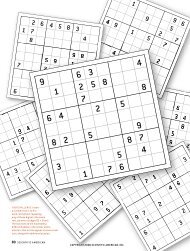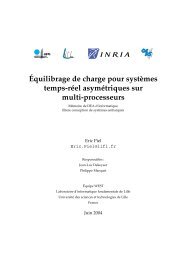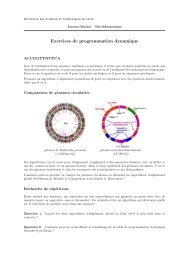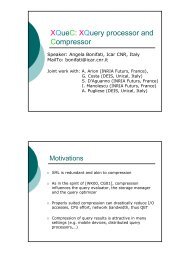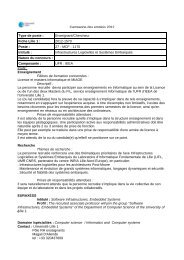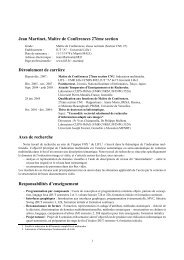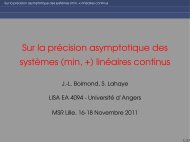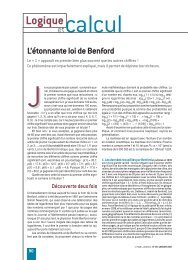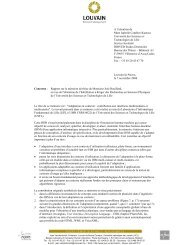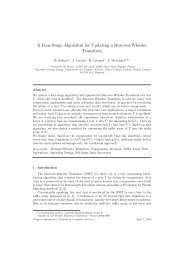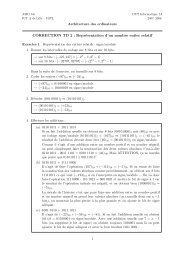Algorithmes de prediction et de recherche de multi-structures d'ARN
Algorithmes de prediction et de recherche de multi-structures d'ARN
Algorithmes de prediction et de recherche de multi-structures d'ARN
You also want an ePaper? Increase the reach of your titles
YUMPU automatically turns print PDFs into web optimized ePapers that Google loves.
42 Chapter 3. Regliss – Locally optimal <strong>structures</strong> <strong>prediction</strong><br />
(a) Initial s<strong>et</strong> of base pairs<br />
(b) Locally optimal secondary <strong>structures</strong><br />
1 2 3 4 5 6 7 8 9 10 11 12 13<br />
1 2 4 6 7 8 9 10 11 12 13 14 1 3 5 6 7 8 9 10 11 12 13 14 2 4 5 7 8 10 12 13<br />
(c) All possible trees corresponding to the construction of locally optimal <strong>structures</strong> from <strong>structures</strong><br />
maximal for juxtaposition<br />
MJ(2, 5)[0] = {(2, 4)}<br />
MJ(3, 3)[0] = ε<br />
MJ(1, 14)[0] = {(1, 6), (7, 8), (9, 14)}<br />
MJ(8, 7)[0] = ε MJ(10, 13)[0] = {(10, 11), (12, 13)}<br />
MJ(11, 10)[0] = ε<br />
(d) States of the push-down stack<br />
(1, 14, −1)<br />
initialization<br />
MJ(13, 12)[0] = ε<br />
MJ(2, 5)[1] = {(3, 5)}<br />
MJ(4, 4)[0] = ε<br />
MJ(1, 14)[1] = {(2, 4), (5, 10), (12, 13)}<br />
MJ(3, 3)[0] = ε MJ(6, 9)[0] = {(7, 8)} MJ(13, 12)[0] = ε<br />
(10, 13, 0)<br />
(2, 5, 0)<br />
(1, 14, 0 )<br />
iteration 1<br />
MJ(8, 7)[0] = ε<br />
(10, 13, 0)<br />
(2, 5, 1 )<br />
(1, 14, 0)<br />
iteration 2<br />
14<br />
MJ(1, 14)[0] = {(1, 6), (7, 8), (9, 14)}<br />
MJ(8, 7)[0] = ε MJ(10, 13)[0] = {(10, 11), (12, 13)}<br />
MJ(11, 10)[0] = ε MJ(13, 12)[0] = ε<br />
(6, 9, 0)<br />
(1, 14, 1 )<br />
iteration 3<br />
Figure 3.7: (a) and (b) come from Figure 3.3. (c) Trees associated to the three locally optimal secondary<br />
<strong>structures</strong>. If (i, j) is a base pair of BP, then MJ(i, j)[k] <strong>de</strong>notes the kth element of MJ(i, j). (d) Contents of<br />
the stack at the end of each iteration of the algorithm of Figure 3.8. MJ(i, j)[k] is symbolized by the tripl<strong>et</strong><br />
(i, j, k). Each iteration outputs a locally optimal structure. Each cell of the stack corresponds to an internal no<strong>de</strong><br />
of the un<strong>de</strong>rlying tree <strong>de</strong>picted in (c). In each iteration, the boxed element is the new MJ(i, j)[k + 1], pushed<br />
by line 5 of the algorithm. All bold elements are then pushed through initializations of lines 6 and 7: their last<br />
component is always 0. For example, at iteration 1, the line 5 pushes the tripl<strong>et</strong> (1, 14, 0), corresponding to<br />
MJ(1, 14)[0] = {(1, 6), (7, 8), (9, 14)}, then the nested <strong>structures</strong> are pushed.



